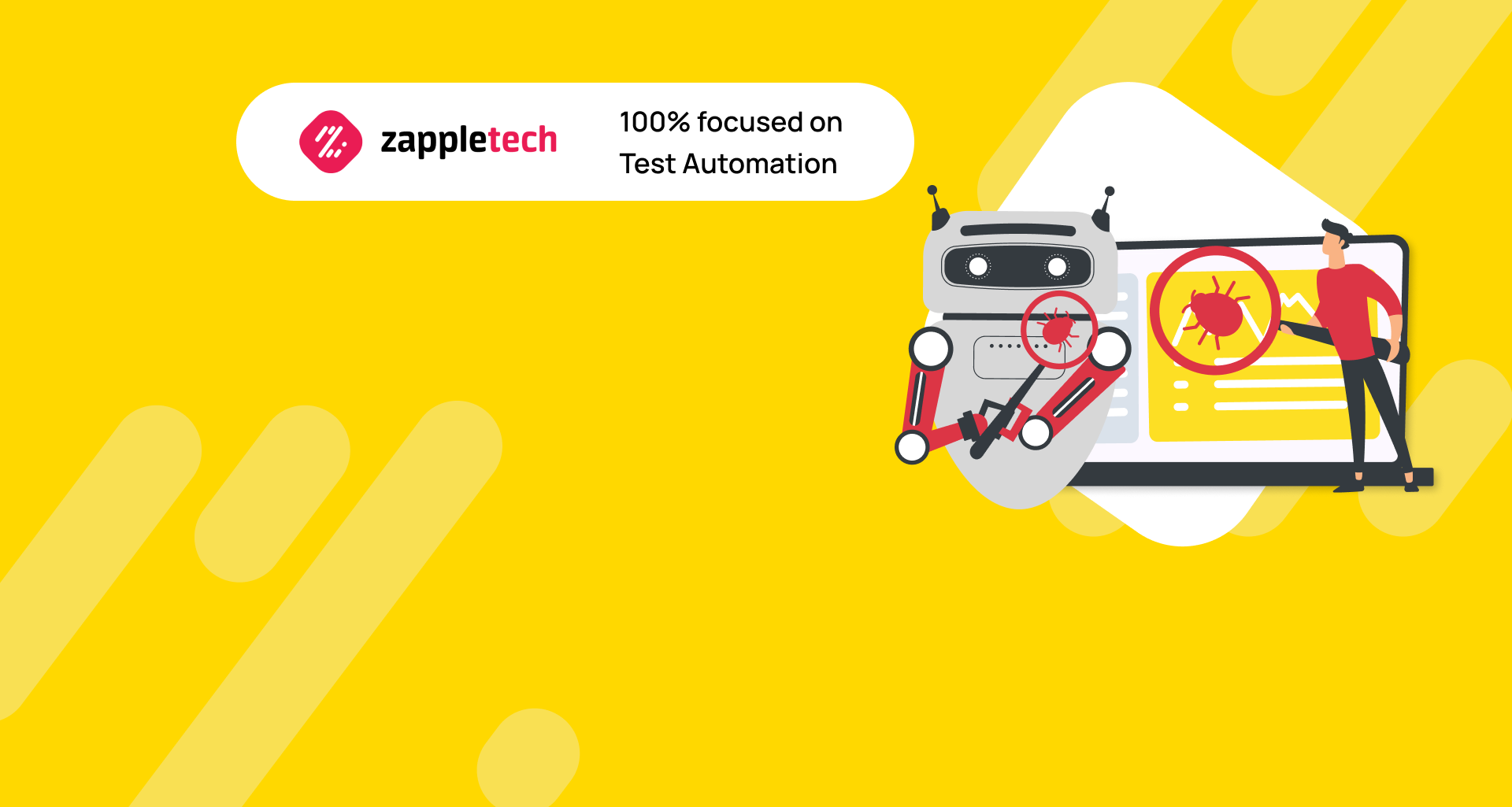The QA industry market is constantly evolving, driven by the need for high-quality digital solutions. According to GMInsight, the market’s value is projected to increase to $40 billion by 2027. This substantial growth is attributed to the rising interest among entrepreneurs and developers in ensuring that their IT solutions meet high-quality standards before release.
Testing digital products in advance addresses many potential issues that could arise post-launch, ensuring a smoother experience for end-users. Depending on the methods, tools, and strategies employed, QA efforts can significantly improve a project, sometimes achieving near-complete elimination of bugs and errors.
For complex, repetitive tasks and large-scale projects, automation QA can save time and ensure consistency. For exploratory or usability testing, manual QA is crucial as human insight is needed.Mykhailo PoliarushCEO, ZappleTech Inc.
The QA industry primarily operates using two approaches: manual QA and automation QA. Each has its own set of strengths and weaknesses, with manual testing often favored for its hands-on, human-driven insights, while automation excels at handling repetitive tasks efficiently. In the ongoing debate of manual QA vs automation QA, choosing the right approach depends on various factors, including project complexity, timelines, and budget.
Today, we’ll explore both methods in detail, comparing manual QA vs automation QA, and discuss whether a hybrid approach can yield the best results for achieving superior software quality.
Table of Contents
Importance of QA Services for Development
CBInsights statistics reveal that approximately 8% of startups in the IT segment fail due to poor digital product quality. This issue often stems from entrepreneurs’ reluctance to allocate sufficient resources for QA outsourcing. Instead of ensuring thorough testing, some startups opt to save costs, which ultimately backfires when the product hits the mass market. The lack of investment in quality assurance can lead to various issues, including negative user reviews, refund demands, or even anti-advertising, all of which tarnish the product’s reputation.
One critical decision startups face is choosing between manual QA vs automation QA. While manual QA allows for a detailed, human-centric approach to finding defects, automation QA can increase efficiency by speeding up repetitive testing tasks. However, neglecting either form of QA can be detrimental, as manual QA often uncovers user experience issues that automation might overlook, while automation QA helps cover a broader range of scenarios quickly. Balancing both methods is key to ensuring the product is market-ready and less prone to the quality-related failures that often plague startups.
App testing solves most of the problems associated with:
Poor performance.
Interface errors.
Poor adaptability.
Broken features.
Incorrect request processing.
Poor integrations.
Each of these problems can turn out to be the final nail in the box that tightly closes users’ entry into an IT product and its entry into the market. That is why QA services are essential when developing any digital solution, from a simple website to a hybrid end-to-end cloud platform.
There are two common testing models: manual and automated QA. They differ significantly in their approach, resource allocation, and, consequently, their overall cost. Deciding between manual QA vs automation QA often depends on project needs, timelines, and complexity.
Manual QA is typically more resource-intensive, requiring testers to manually execute test cases. This method is more flexible and suitable for exploratory testing, usability testing, and scenarios that require human intuition. However, it can become time-consuming and prone to human error.
On the other hand, automation QA relies on scripts and software to execute repetitive test cases, making it more efficient for larger projects with frequent updates. Automated testing is ideal for regression testing, performance testing, and ensuring continuous integration. While the initial setup of automation requires investment, it reduces long-term costs and accelerates the testing process.
This comparison between manual QA vs automation QA highlights their unique strengths and weaknesses, helping you decide which is more suitable for your product’s testing strategy.
Challenges of Each Type of Testing
Outsourcing both manual and automated QA testing can bring great value to businesses, but there are times when combining both methods is the optimal solution to overcome specific challenges.
Manual testing can indeed be monotonous and time-consuming. For example, repetitive tasks, such as checking the same feature across different environments or devices, can lead to tester fatigue, making it prone to human error. While manual testing is crucial for scenarios that require a human perspective—like usability or exploratory testing—repeating the same tests manually over and over doesn’t make sense.
In such cases, automated testing can complement manual efforts by handling the repeatable and routine tasks. Automation tools can execute tests faster and with more precision, ensuring that regression tests, performance tests, or other repetitive tasks are covered efficiently. This allows the manual testers to focus on more critical, complex, or creative tasks like exploratory testing or assessing new features.
Challenges that arise during manual testing:
The time cost of repeating the same operation with different inputs. For example, if we are testing a function where the value must respond to a certain range of data, there is a chance of missing a bug even with a selective test. And sometimes, hundreds of such repetitions are required.
Working with multiple copies of the app for different platforms. When you need to test the same function or element on various platforms, this process stretches for a long time. There are only two ways out: hire more testers or automate the process.
The human factor influence on the result. It is a manual input error that can lead to the bug being not detected in time, and the function turns out to be broken and not fixed in the final builds. This will entail additional costs to fix the IT solution.
Despite all the flaws, manual testing is beneficial in some cases. For example, when you need to check one or more functions, interface elements, or code with a minimum number of conditions and factors affecting the result.
Automation Challenges:
Preparing Scripts for Testing. It is with writing scripts and commands that automation begins. It is performed both directly during the sprints and before they start. Often scripts need to be prepared before development begins.
Specialist skill requirements. An ordinary tester is not trained to manage the algorithms of automated test environments. This work often involves experts from the development department who can use a programming language to create scripts.
The need for an abundance of tools. The technical aspects of automation require different frameworks and test environments to implement scenarios. For example, testing tools for desktop, mobile, and web apps are entirely different.
Already, the coverage of test cases by automation is about 90%, but the coverage will be complete in the future. Both the rapid development of the QA industry and the challenges that need to be addressed with innovative methods contribute to this.
Benefits of Automation Testing
Covering test cases with modern testing tools not only improves efficiency but also addresses the challenges in the debate of manual QA vs automation QA. While manual testing plays a critical role in exploring unique scenarios and identifying edge cases, automation excels in handling repetitive tasks. By delegating routine processes to algorithms, you can disperse the resources of test automation outsourcing executors to solve more complex problems. This allows specialists to focus on non-trivial issues, ultimately improving the overall quality of the software. Additionally, automation minimizes the risk of missing critical bugs and ensures consistent quality across IT resources, making it a strong complement to manual QA efforts.
Advantages:
Almost complete coverage of test cases.
Large selection of test environments and platforms.
A wide arsenal of available tools.
Minimizing the chances of missing bugs.
Reducing the number of routine processes.
Ability to parallelize tests for all platforms.

Automation allows getting rid of the manual repetition of the same action under different circumstances. This is a significant advantage in the debate of manual QA vs automation QA. In manual testing, QA experts must repeat the same test case for different scenarios, which can be time-consuming and prone to human error. However, with automation, after spending some time, a QA expert from QA outsourcing companies can write all the action variations in one script and run it in a loop. This process not only reduces human effort but also increases accuracy by eliminating the risk of overlooked errors.
As a result, the tester will receive a detailed report or an array of data describing the entire process and the app’s reactions to specific actions. This automation aspect really speeds up the testing phase, allowing for quicker iterations and feedback, which ultimately improves the final quality of the digital product. When comparing manual QA vs automation QA, it’s clear that automation offers the ability to run tests more frequently and efficiently, especially for regression tests or high-complexity scenarios.
Benefits of Manual Testing
Traditional manual testing has long been the backbone of the QA industry, providing a foundation for quality assurance processes across various industries. While standard methods and techniques in manual testing have remained relatively consistent over time, they have fully adapted to the demands of modern Agile methodologies. This evolution ensures that manual testing continues to play a vital role, even as automated testing gains more traction. The debate between manual QA vs automation QA often centers around efficiency and speed, with manual testing seen as slower and more labor-intensive.
Despite losing some popularity, manual testing is still in high demand in the labor market. Its value lies in the diligence and thoroughness required in certain scenarios where human intuition and exploratory testing are crucial. The effectiveness of manual testing, when done correctly, can rival that of automation. However, it typically requires more time and effort from testers, making it essential in cases where flexibility and adaptability are needed. While automated QA can handle repetitive tasks with high speed, manual QA remains essential for nuanced testing that requires human judgment. This ongoing discussion highlights the complementary roles of manual QA vs automation QA in the quality assurance field.
Advantages of manual testing:
Can be done spontaneously when needed.
Each test case is described detailed, and a report is compiled as a result.
Selective urgent testing of individual functions or elements.
Fits perfectly into sprint schedules.
Allows you to check single cases.
Does not require special skills from performers.

Manual testing is the foundation of the entire QA industry and should not be neglected. While full hyper-automation is only a dream, manual tests are necessary to ensure the highest possible quality of digital products.
What Is More Effective: Manual or Automation QA
The dilemma of choosing between manual and automated testing is still acute. Many entrepreneurs try to give preference to only one method, forgetting that they complement each other and comprehensively solve all the tasks.
Rapid detection of bugs is possible only by combining all the available elements. For example, if testing is parallelized and automated, then the specialist has enough free time to test individual functions, integrations, and interfaces manually. Thus, by the time the current script is closed, it is possible to check almost all the finished code for operability.
In terms of efficiency, automatic testing is a clear winner. It covers almost all test cases and optimizes resource consumption. And such types of testing, for example, regression, functional, or interface in modern realities, are challenging to carry out manually. This is due to a large number of repetitive actions and parameters that should be checked.
Examples of Testing Types and the Feasibility of Their Automation
Let’s consider the basic types of testing that are used in almost any development of all types of apps. Their common feature is a large number of processes and actions that experts need to perform to most effectively identify bugs. In the context of software testing, two primary approaches are widely used: manual QA and automation QA.
Manual QA involves testers executing test cases by hand, simulating user interactions with the app to ensure that it functions as expected. This type of testing is particularly useful for exploratory and usability testing, where human intuition and flexibility play a significant role. However, manual QA can be time-consuming and prone to human error, especially when dealing with repetitive tasks or large-scale projects.
On the other hand, automation QA uses scripts and tools to automatically execute tests, offering a faster and more consistent method for validating the functionality of applications. Automation is highly efficient for regression testing, where repetitive tests must be run each time the software is updated. By comparing manual QA vs automation QA, it’s clear that while manual testing is essential for unique, one-off test cases, automation QA excels in delivering speed and accuracy over time, particularly in continuous integration and delivery pipelines.
Both approaches have their strengths, and the choice between manual QA and automation QA often depends on the complexity, scale, and frequency of testing required for the project at hand.
End-to-End Testing
Simulating real user actions is one of the best ways to identify major problems and bugs in a software system. In the context of manual QA vs automation QA, both methods have their strengths, but automation plays a crucial role in improving efficiency. Automated testing allows teams to use available resources more effectively while ensuring complete coverage of quality assurance tasks related to user experience.
Automation can handle repetitive and large-scale tests quickly, which is why it’s the preferred method for most testing processes. However, there are still certain scenarios where manual QA comes into play. These manual tests, though making up no more than 10% of the overall process, are essential for focusing on specific elements that require a human touch or judgment. Despite automation being predominant, manual QA ensures quick verification of unique cases where human intuition may catch something that automated systems miss.
In manual QA vs automation QA, the choice often depends on the complexity of the test scenario. While automation provides extensive and repeated coverage, manual testing ensures a detailed focus on individual elements. Both approaches together create a balanced and robust testing strategy, ensuring that all aspects of a product are fully vetted for quality and performance.
Automation QA typically has higher upfront costs due to setup but pays off with time efficiency in the long run. Manual QA may be more cost-effective for short-term or smaller projects.Sergey AlmyashevCOO, ZappleTech Inc.
Interface Testing
Regardless of the type of app and the platform on which it is built, interface testing works best in an automated manner. There are several reasons for this:
Most tests can be scripted.
Scripts can be run in parallel on different platforms.
A detailed log allows you to track the stability of a product recall.
You can test each button long and hard, enter different values in fields, or perform other actions, but it’s much easier and faster to automate scenarios with scripts and run them cyclically. Cloud platforms are used to reduce the load on the working device, which provides opportunities for parallelizing tests.
Acceptance Testing
Each test suite element that includes acceptance testing is already being automated. This type is focused on comparing the actual performance and functionality with the desired one. At this very stage, automation plays a key role because manually testing all the app components is long and very problematic.
Functional Testing
This type of QA service implies thorough testing of both individual elements of the app and their interaction as a whole. A very costly kind of testing, in which automation is indispensable. Scenarios and scripts allow you to quicken the process of finding bugs dozens of times by parallelizing efforts for different platforms simultaneously.
Load Testing
Stress testing of each element and the entire system is impossible without the use of scripts that automate and loop certain actions. These include even a repeated request to the server with a frequency of 1-15 ms, which can reveal problems with processing data or respond directly to the back-end part of the app. The same goes for performance. It is measured by performing repeated actions in a limited period. Basically, this testing can be carried out manually, but the efficiency will be much higher with automation.
Summarizing
Manual and automated testing complement each other in a comprehensive QA process, offering a balanced approach to ensure full coverage of test scenarios. While manual QA allows testers to explore and identify issues based on human intuition, automation QA excels in running repetitive tasks with high accuracy and speed. Each method compensates for the limitations of the other, enabling a more thorough examination of software. By using both methods, teams can ensure quality and identify the “blind spots” that may be missed by relying on one approach alone.
If you’re looking for a full-scale manual QA vs automation QA solution for your app, ZappleTech has the expertise to guide you. Our specialists are skilled in combining both types of testing to address all your software’s quality needs. Contact our company for expert advice and let us handle your testing challenges with precision and efficiency.
ZappleTech is a leader in high-tech and QA services, committed to providing top-tier solutions.





